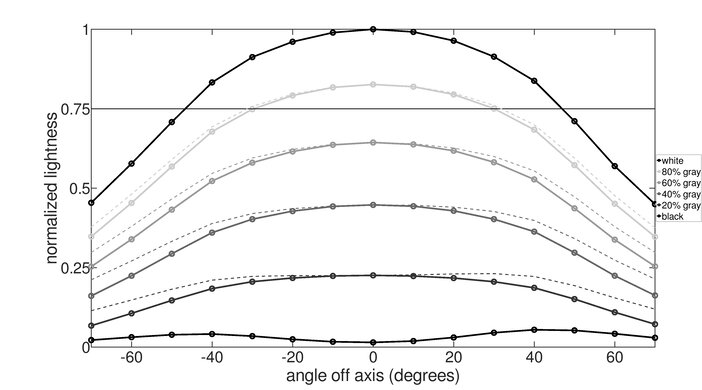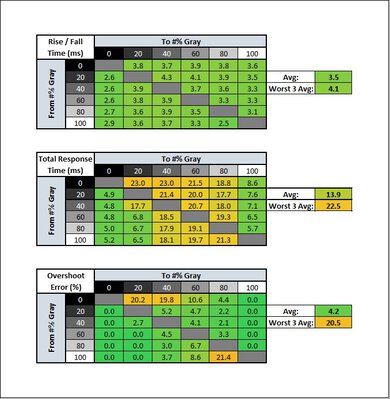The LG 34GN850-B is an overall good monitor with impressive gaming performance. It has a 1440p resolution on a 34 inch screen, delivering an immersive gaming experience as well as plenty of screen real estate for productivity tasks. The screen is lightly curved and it can get bright enough for use in moderately-lit rooms. Its superb response time and high refresh rate result in clear images with very little motion blur, and it comes with native FreeSync support and G-SYNC compatibility. Sadly, it doesn't perform all that well in dark environments due to its low contrast ratio, and it doesn't have a local dimming feature either. On the upside, it supports HDR and it has an sRGB mode that produces colors with great accuracy.
Our Verdict
The LG 34GN850-B is a good monitor for most uses. Although it's mainly made for gaming and it performs impressively well in that regard, it's also a good choice for productivity and media consumption. Its 21:9 aspect ratio is great for multitasking, and its excellent coverage of the Adobe RGB color space makes it suitable for content creators. Unfortunately, its sub-par contrast ratio makes it less suitable for dark rooms, and its ergonomics are poor, as it can't swivel or rotate to portrait mode.
- Superb response time.
- Great out-of-the-box color accuracy.
- Exceptionally low input lag.
- Sub-par contrast ratio.
- Poor ergonomics.
The LG 34GN850-B is a good office monitor. Its large screen size is great for multitasking, and its 1440p resolution renders text clearly. It gets bright enough for most office settings, and it handles reflections decently well. Sadly, its ergonomics are rather poor and although its IPS panel has decent horizontal viewing angles, it's not as good as most IPS monitors.
- Superb response time.
- Great out-of-the-box color accuracy.
- Exceptionally low input lag.
- Sub-par contrast ratio.
- Poor ergonomics.
The LG 34GN850-B is an impressive gaming monitor. It has a large high-resolution screen, superb response time, and an exceptionally low input lag. It supports FreeSync natively and it's also certified to be compatible with recent NVIDIA graphics cards. However, it's not the best choice for dark room gaming and the stand's poor ergonomics make it harder to adjust the monitor to your optimal viewing position.
- Superb response time.
- Great out-of-the-box color accuracy.
- Exceptionally low input lag.
- Sub-par contrast ratio.
- Poor ergonomics.
The LG 34GN850-B is a good monitor for media consumption. It delivers good picture quality thanks to its high resolution, and its large, curved screen is great for immersion. While its IPS panel provides decent viewing angles, it's not the best for watching in the dark due to the low contrast ratio. It gets bright enough for most rooms, but it may struggle a bit if there's a lot of sunlight.
- Superb response time.
- Great out-of-the-box color accuracy.
- Exceptionally low input lag.
- Sub-par contrast ratio.
- Poor ergonomics.
The LG 34GN850-B is a good monitor for content creators. Its large screen size and ultrawide format are great for having multiple windows open at the same time. Gray uniformity is excellent, gradient handling is superb, and it has excellent coverage of the Adobe RGB color space. Unfortunately, it can't swivel or rotate to portrait mode, and there's a bit of backlight bleed as well, although the latter can vary per unit.
- Superb response time.
- Great out-of-the-box color accuracy.
- Exceptionally low input lag.
- Sub-par contrast ratio.
- Poor ergonomics.
The LG 34GN850-B is alright for HDR. While it displays the wide range of colors needed for HDR, it doesn't get bright enough to make them look vivid or for highlights to pop. It also struggles in dark rooms as blacks look gray in the dark, and it lacks a local dimming feature to further improve it.
- Superb response time.
- Great out-of-the-box color accuracy.
- Exceptionally low input lag.
- Sub-par contrast ratio.
- Poor ergonomics.
Changelog
- Updated Feb 07, 2023: Added text in the macOS Compatibility and Console Compatibility boxes and clarified text throughout as part of Test Bench 1.2.
- Updated Feb 06, 2023: Updated to Test Bench 1.2, resulting in changes to the results and scores with the Response Time and Input Lag. Added tests for Console Compatibility and macOS compatibility and made minor changes to other tests, which you can see in our Changelog.
- Updated Jun 09, 2020: Retested to see if it can display chroma 4:2:2 at 160Hz with 10-bit color depth.
- Updated Jun 02, 2020: Review published.
Check Price
Differences Between Sizes And Variants
We tested the LG 34GN850-B and it's only available in a 34 inch size. However, this is only one of several monitors in LG's UltraGear Gaming monitor lineup, which has over a dozen models available in various configurations.
If someone comes across a different type of panel or if their LG 34GN850-B doesn't correspond to our review, let us know and we'll update the review. Note that some tests, such as the gray uniformity, may vary between individual units.
Our unit of the LG 34GN850-B was manufactured in April 2020, you can see the label here.
Popular Monitor Comparisons
The LG 34GN850-B is an overall good monitor. It's one of the best 21:9 ultrawide gaming monitors that we've reviewed so far and it's cheaper than other similar monitors. However, it's not the best choice for dark room gaming due to its low contrast ratio and its horizontal viewing angles aren't as good as other IPS monitors. For other options, you can also see our recommendations for the best gaming monitors, the best ultrawide gaming monitors, and the best 144Hz monitors.
The LG 34GP83A-B and the LG 34GN850-B are almost identical in design, features, and performance. The main differences are that the 34GN850-B has slightly better response time at max refresh rate, and it gets a bit brighter in HDR, although not by much.
The LG 34GN850-B and the Dell S3422DWG are both ultrawide gaming monitors, but there are a few differences due to their panel types. The LG has an IPS panel with much better motion handling and an overclock feature for a slightly higher 160Hz refresh rate. The LG also delivers a more realistic image thanks to its better accuracy before calibration. On the other hand, the Dell gets brighter in HDR for a more vivid image, and it's also the better choice for dark room gaming as it delivers deeper blacks.
The LG 34GN850-B and the LG 34GP950G-B are very similar overall. The 34GP950G has a slightly higher refresh rate and a faster response time when gaming at 60Hz. There's also a difference in the supported gaming technologies. The 34GP950G is a native G-SYNC monitor, whereas the 34GN850-B supports FreeSync, so if you want to get the most out of your graphics card, it might be better to get the one that matches your card.
The LG 34GN850-B is better overall than the Samsung Odyssey G55T C34G55T, but they have different panel types. The LG has an IPS panel with wide viewing angles, while the Samsung has a VA panel with a higher contrast ratio. The LG is a bit better for gaming because it has a much quicker response time that results in smoother motion, and it gets brighter overall than the Samsung, making it a better choice for HDR gaming.

We buy and test more than 30 monitors each year, with units that we buy completely on our own, without any cherry-picked units or samples. We put a lot into each unbiased, straight-to-the-point review, and there's a whole process from purchasing to publishing, involving multiple teams and people. We do more than just use the monitor for a week; we use specialized and custom tools to measure various aspects with objective data-based results. We also consider multiple factors before making any recommendations, including the monitor's cost, its performance against the competition, and whether or not it's easy to find.
Test Results

The LG 34GN850-B has a simple design that looks like most gaming monitors in LG's UltraGear lineup. It has thin bezels on all sides and the screen is curved. The stand is a bit different compared to other LG UltraGear monitors, so only the tips of the V-shaped stand make contact with the table. There are some red accents on the stand and the back of the monitor, but they don't light up.
Unfortunately, the LG 34GN850-B has poor ergonomics. It can't rotate to portrait mode due to its aspect ratio and curvature, and it can't swivel either. There's a decent amount of height adjustment, but the tilt range is limited. If you want a similar monitor with better ergonomics, check out the Acer Nitro XV340CK.
The back of the monitor is plain and looks like most LG UltraGear gaming monitors. The red accents don't light up and there's a small cutout on the stand that serves as cable management.
The LG 34GN850-B has a sub-par contrast ratio, which is expected of most IPS panels. This makes blacks look grayish, especially in a dark environments. If you want something with a VA panel and a higher contrast, check out the AOC CU34G2X.
The LG 34GN850-B doesn't have a local dimming feature. The video above is provided for reference only.
Great SDR peak brightness. It's bright enough for moderately-lit rooms, but it may struggle to overcome glare in very bright rooms. Thankfully, there's almost no variation in brightness when displaying different content.
If you want a monitor that can get brighter, check out the LG 38GL950G-B.
HDR peak brightness is decent and is very consistent across different content. It's good enough to deliver an okay HDR gaming experience, but not for HDR movies.
Decent horizontal viewing angle, although not as good as most IPS panels. Black level rise and gamma shift happen fairly quickly when moving off-center, but colors remain accurate until you reach moderate viewing angles.
The LG 34GN850-B has good vertical viewing angles; however, colors can appear washed out at the top and bottom of the screen if you sit very close.
The LG 34GN850-B has excellent out-of-the-box color accuracy. The monitor has an sRGB mode that displays most colors accurately; however, white balance is a bit off, and the color temperature is warmer than the 6500K target. Gamma follows the curve for the most part, although dark scenes tend to be over-darkened. Unfortunately, using the sRGB mode locks many settings, like Adaptive Sync and Response Time, so if you want to use those settings, you need to use another, less accurate picture mode.
After calibration, the LG 34GN850-B's color accuracy is superb. White balance and gamma are nearly perfect, and the color temperature is much closer to our 6500K target.
Exceptional SDR color gamut. The LG 34GN850-B can display the full sRGB color space used in most content, and it has excellent coverage of the Adobe RGB color space, which is great for content creators.
You can only reach its overclockable 160Hz refresh rate with a DisplayPort connection, and you need to have VRR enabled. Additionally, the max refresh rate is limited over HDMI due to bandwidth limitations.
It supports FreeSync natively and has been certified by NVIDIA to be compatible with G-SYNC. However, G-SYNC only works through a DisplayPort connection. If you prefer a monitor with native G-SYNC support, check out the LG 34GP950G-B instead.
| Overdrive Setting | Response Time Chart | Response Time Tables | Motion Blur Photo |
| Off | Chart | Table | Photo |
| Normal | Chart | Table | Photo |
| Fast | Chart | Table | Photo |
| Faster | Chart | Table | Photo |
The LG 34GN850-B has superb response time when playing at its maximum refresh rate. The 'Normal' Overdrive setting provides the best performance with less overshoot than 'Fast' and 'Faster'.
| Overdrive Setting | Response Time Chart | Response Time Tables | Motion Blur Photo |
| Off | Chart | Table | Photo |
| Normal | Chart | Table | Photo |
| Fast | Chart | Table | Photo |
| Faster | Chart | Table | Photo |
The response time at 120Hz is excellent. Once again, there's minimal blur, and 'Normal' is the recommended overdrive setting, as there's hardly any overshoot. Interestingly, you need to create a custom resolution to send a fixed 120Hz signal, but 120Hz works fine with VRR enabled if you set a higher refresh rate and the frame rate of your source drops to 120.
| Overdrive Setting | Response Time Chart | Response Time Tables | Motion Blur Photo |
| Off | Chart | Table | Photo |
| Normal | Chart | Table | Photo |
| Fast | Chart | Table | Photo |
| Faster | Chart | Table | Photo |
The 60Hz response time is good. Although the total response time is slower than with higher frame rate signals, it's still good. The 'Normal' setting still has less overshoot than 'Fast' and 'Faster'.
The LG 34GN850-B doesn't have a black frame insertion feature.
The LG 34GN850-B has an exceptionally low input lag for a responsive feel while gaming.
The LG 34GN850-B has an excellent resolution and size. Its ultrawide format is well-suited for gaming and for productivity, and its high resolution delivers detailed images and clear text.
The LG 34GN850-B works well with the PS5. It downscales a 4k image, which results in a sharper image than a native 1440p signal. However, the PS5 doesn't support ultrawide gaming, so you'll see black bars on the sides.
This monitor works well with the Xbox Series X. It downscales a 4k image, which results in a sharper image than a native 1440p signal. Unlike some other monitors, you don't need to enable the HDMI override for 1440p @ 60Hz to work. The Xbox doesn't support ultrawide gaming, so you'll see black bars on the sides.
The LG 34GN850-B works well with recent M1 MacBooks. The VRR only works up to 144Hz, so if you want to use the overclockable 160Hz, you need to use a fixed refresh rate instead. There aren't any noticeable issues with VRR in the desktop and in games, except there's a thin gray bar at the top of the screen in games, similar to the LG 34GP83A-B. HDR looks fine, but the max refresh rate with HDR is 100Hz, and you can't use VRR at the same time. Windows return to their original position when you wake the laptop up from sleep or open the lid, which is great.
The LG 34GN850-B comes with a few extra features, including:
- Crosshair: Adds on-screen crosshair for shooter games.
- Black Stabilizer: Makes objects in dark scenes more visible.
- DAS (Dynamic Action Sync): Helps minimize input lag. This feature is enabled automatically when playing at the monitor's maximum refresh rate and can't be disabled.



















































